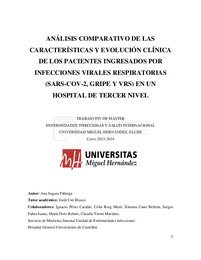Por favor, use este identificador para citar o enlazar este ítem:
https://hdl.handle.net/11000/35527Análisis comparativo de las características y evolución clínica de los pacientes ingresados por infecciones virales respiratorias (Sars-Cov-2, Gripe y VRS) en un hospital de tercer nivel
| Título : Análisis comparativo de las características y evolución clínica de los pacientes ingresados por infecciones virales respiratorias (Sars-Cov-2, Gripe y VRS) en un hospital de tercer nivel |
| Autor : Segura Fábrega, Ana |
| Tutor: Usó Blasco, Jorge |
| Editor : Universidad Miguel Hernández |
| Fecha de publicación: 2024-09-04 |
| URI : https://hdl.handle.net/11000/35527 |
| Resumen : Introducción: Durante las diferentes olas de la pandemia de la Covid-19, la incidencia de gripe y virus respiratorio sincitial (VRS) disminuyó, en parte, por las medidas de aislamiento. En 2022/2023, estos virus reaparecen en detrimento del SARS-CoV-2, por lo que surge la necesidad de evaluar cómo se comportan, actualmente, a nivel hospitalario. Objetivo: Comparar las características de los pacientes que ingresan en Medicina Interna del HGUCS por infección viral (SARS-CoV-2, VRS o Gripe) y analizar la evolución clínica (representada por la estancia hospitalaria, mortalidad por cualquier causa durante el ingreso y a los 90 días del ingreso y necesidad de reingreso a los 90 días del alta) en función de qué infección viral han presentado e investigar qué factores pueden influir en ella. Material y métodos: Estudio de cohortes retrospectivo en un hospital de tercer nivel entre el 1 de noviembre de 2023 y el 15 de marzo de 2024, en pacientes ≥18 años ingresados en MIN/UEI con infección respiratoria confirmada microbiológicamente por gripe, Covid-19 o VRS. Se excluyeron las coinfecciones por más de uno de los virus incluidos. Resultados: Se incluyeron 116 pacientes (56% mujeres; mediana de edad 86 años; 67,28% SARS-CoV-2, 53,36 % gripe A y 13,92 % VRS). Hubo mayor enolismo en gripe A y mayor PCR al ingreso, mortalidad durante el ingreso y a los 90 días del ingreso en el subgrupo de SARS-CoV-2. La mortalidad global durante el ingreso fue de 14,7%, a los 90 días de 28,4% y reingresaron 34 pacientes (29,3%) a los 90 días del alta. La insuficiencia renal crónica y la vacunación de SARS-CoV-2 se mostraron como factores protectores sobre la estancia hospitalaria, mientras que la sobreinfección bacteriana como factor de riesgo. La hipertensión arterial se mostró como factor protector sobre la mortalidad a los 90 días del ingreso, sin embargo, el uso de ventimask, la neoplasia sólida y la edad lo hicieron como factores de riesgo. En el reingreso a los 90 días del alta, la diabetes mellitus tipo 2, la neoplasia sólida y el índice de Charlson se mostraron como factores de riesgo. Conclusiones: Según los resultados, pese a que las características basales eran similares en los 3 virus, la mortalidad en el ingreso y a los 90 días de este fue mayor en los pacientes ingresados por SARS-CoV-2. Se identificaron varios factores de riesgo como la sobreinfección bacteriana, el uso de ventimask, la presencia de neoplasia sólida, la edad, la diabetes mellitus tipo 2 y el índice de Charlson Introduction: During the different waves of the Covid-19 pandemic, the incidence of influenza and respiratory syncytial virus (RSV) decreased, in part, due to isolation measures. In 2022/2023, these viruses reappear to the detriment of SARS-CoV-2, so the need arises to evaluate how they currently behave at the hospital level. Objective: To compare the characteristics of patients admitted to HGUCS Internal Medicine for viral infection (SARS-CoV-2, RSV or Influenza) and to analyze the clinical evolution (represented by hospital stay, all-cause mortality during admission and 90 days after admission and need for readmission 90 days after discharge) according to which viral infection they have presented and to investigate which factors may influence it. Methods: Retrospective cohort study in a tertiary level hospital between November 1, 2023 and March 15, 2024, in patients ≥18 years admitted to MIN/UEI with microbiologically confirmed respiratory infection due to influenza, Covid-19 or RSV. Coinfections by more than one of the included viruses were excluded. Results: 116 patients were included (56% women; median age 86 years; 67.28% SARS-CoV-2, 53.36% influenza A and 13.92% RSV). There was higher enolism in influenza A and higher CRP at admission, mortality during admission and 90 days after admission in the SARS-CoV-2 subgroup. Overall mortality during admission was 14.7%, at 90 days 28.4% and 34 patients (29.3%) were readmitted 90 days after discharge. Chronic renal failure and SARS-CoV-2 vaccination were shown to be protective factors for hospital stay, while bacterial superinfection was shown to be a risk factor. Arterial hypertension was shown as a protective factor on mortality at 90 days after admission; however, ventimask use, solid neoplasm and age were shown as risk factors. On readmission 90 days after discharge, type 2 diabetes mellitus, solid neoplasia and Charlson index were shown as risk factors. Conclusions:According to the results, despite the fact that baseline characteristics were similar in the 3 viruses, mortality on admission and at 90 days after admission was higher in patients admitted for SARS-CoV-2. Several risk factors were identified such as bacterial superinfection, use of ventimask, presence of solid neoplasm, age, type 2 diabetes mellitus and Charlson index. |
| Palabras clave/Materias: SARS-CoV-2 virus de la Influenza A virus sincitial respiratorio humano evolución clínica readmisión del paciente patient readmission |
| Área de conocimiento : CDU: Ciencias aplicadas: Medicina: Patología. Medicina clínica. Oncología |
| Tipo de documento : info:eu-repo/semantics/masterThesis |
| Derechos de acceso: info:eu-repo/semantics/openAccess Attribution-NonCommercial-NoDerivatives 4.0 Internacional |
| Aparece en las colecciones: TFM-M.U Enfermedades Infecciosas y Salud Internacional |
 La licencia se describe como: Atribución-NonComercial-NoDerivada 4.0 Internacional.
La licencia se describe como: Atribución-NonComercial-NoDerivada 4.0 Internacional.
.png)
